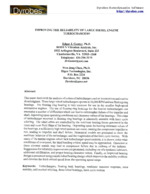Papers
“Improving the Reliability of Large Diesel Engine Turbochargers,” |
Abstract:
This paper deals with the analysis of a class of turbocharger used on locomotives and marine diesel engines. These larger sized turbochargers operate at 30,000 RPM and use floating ring bearings. The floating ring bearing is very common for use in the smaller high-speed automotive engines. The use of floating ring bearings for the heavier turbochargers can encounter a number of difficulties which can lead to catastrophic failure of the impeller and shaft, depending upon operating conditions and clearance values of the bearings. This class of turbocharger mounted in floating ring bearings is inherently unstable with limit cycle whirling. The whirl orbits are controlled by the nonlinear bearing forces generated in the inner and outer fluid films of the bearing. Depending upon the bearing clearance values of the bearings, a sufficiently high whirl motion can occur, causing the compressor impeller to rub, leading to impeller and shaft failure. Dynamical models are presented to show the nonlinear behavior of the turbocharger and the magnitudes of the limit cycle motion. With many of the marine engines which lack turbocharger speed controls, it is shown under what conditions of overspeed, the third bending critical speed may be approached. Operation at these elevated speeds may lead to compressor failure due to rubbing of the inducer. Suggestions for reliability improvement are presented, including use of a synthetic lubricant, additional oil filtration, and proper bearing clearance values. Finally, an improved bearing design is presented using a multi-lobed bearing design which improves the stability problem and elevates the third critical speed from the operating speed range.
Keywords:
Turbochargers, floating bush bearings, nonlinear transient response, rotor stability, self-excited whirling, three-lobed bearings, limit cycle motion

